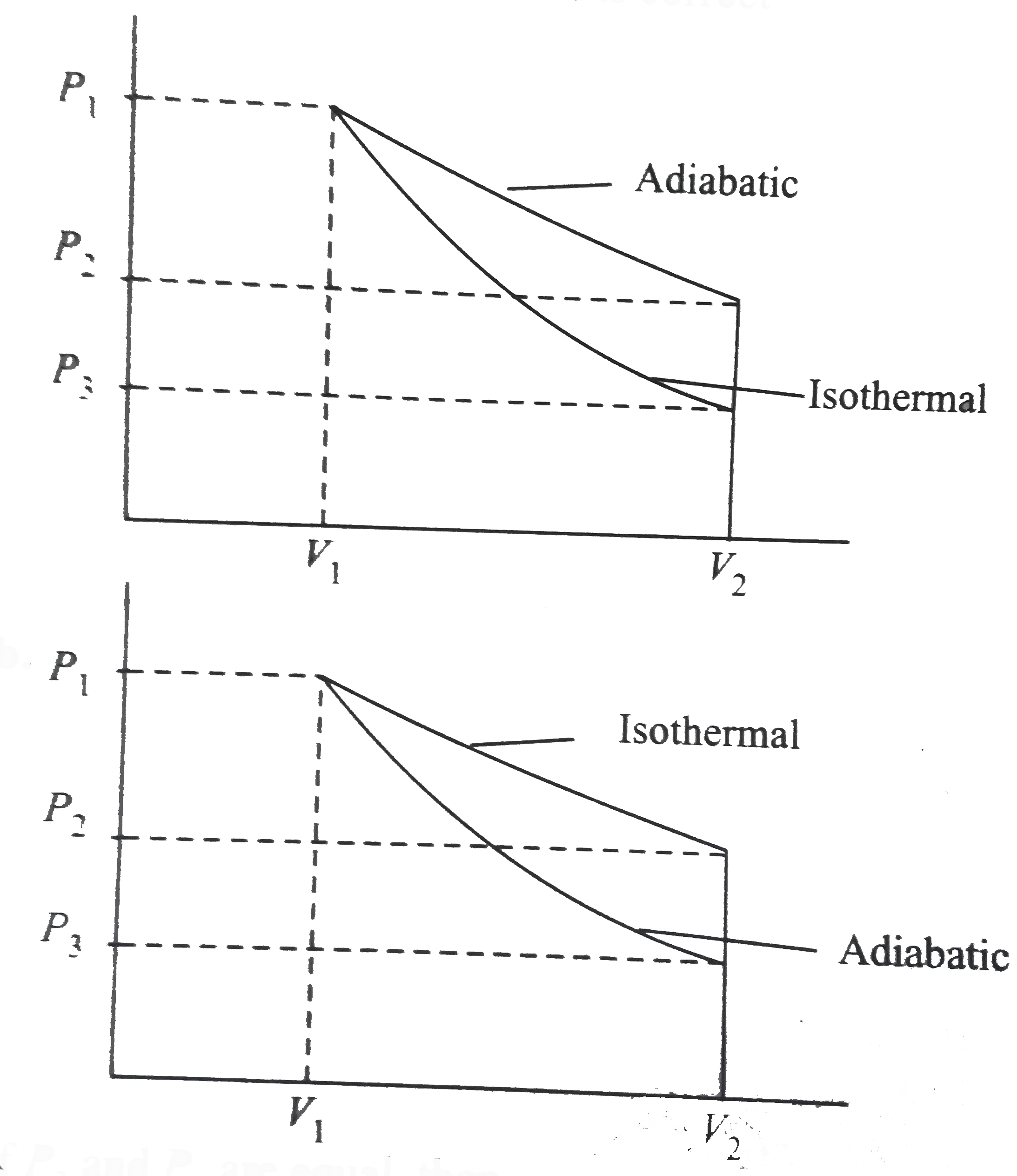1mol of an ideal gas undergoes reversible isothermal expansion form an initial volume V1 to a final volume 10V1 and does 10kJ of work. The initial pressure was 1×107Pa.
a. Calculate V2.
b. If there were 2mol of gas, what must its temperature have been?
0.003, 275 K
0.00043, 261.13 K
0.0005, 300 K
0.00049, 353 K
To solve the given problem step by step, we will break it down into two parts as per the question.
Part (a): Calculate V2
1. Understanding the Process: We have 1 mole of an ideal gas undergoing a reversible isothermal expansion from an initial volume V1 to a final volume V2=10V1. The initial pressure P1 is given as 1×107 Pa.
2. Using the Ideal Gas Law: The ideal gas law is given by:
PV=nRT
Since the process is isothermal, we can use the relationship between pressures and volumes:
P1V1=P2V2
3. Finding P2: We know that V2=10V1. Therefore, we can express P2 in terms of P1 and V1:
P2=P1V1V2=P1V110V1=P110
Substituting for P1:
P2=1×107Pa10=1×106Pa
4. Calculating Work Done: The work done during the isothermal expansion is given by:
W=−2.303nRTlog(P1P2)
Given W=10kJ=10×103J, we can rearrange to find T:
10×103=−2.303×1×R×T×log(10)
Here, log(10)=1, and R=8.314J/(mol K).
5. Solving for Temperature T:
10×103=−2.303×1×8.314×T
T=−10×103−2.303×8.314
T≈522.271K
6. Finding V1: Now we can find V1 using the ideal gas law:
V1=nRTP1=1×8.314×522.2711×107
V1≈4.342×10−4m3
7. Calculating V2:
V2=10V1=10×4.342×10−4=4.342×10−3m3
Part (b): If there were 2 moles of gas, what must its temperature have been?
1. Using the Work Done Equation Again: For 2 moles, we can use the same work done equation:
W=−2.303nRTlog(P1P2)
Substituting n=2:
10×103=−2.303×2×8.314×T
2. Solving for Temperature T:
T=−10×103−2.303×2×8.314
T≈261.135K
Final Answers:
- (a) V2=4.342×10−3m3
- (b) T≈261.135K
PV=nRT
Since the process is isothermal, we can use the relationship between pressures and volumes:
P1V1=P2V2
P2=P1V1V2=P1V110V1=P110
Substituting for P1:
P2=1×107Pa10=1×106Pa
W=−2.303nRTlog(P1P2)
Given W=10kJ=10×103J, we can rearrange to find T:
10×103=−2.303×1×R×T×log(10)
Here, log(10)=1, and R=8.314J/(mol K).
10×103=−2.303×1×8.314×T
T=−10×103−2.303×8.314
T≈522.271K
V1=nRTP1=1×8.314×522.2711×107
V1≈4.342×10−4m3
V2=10V1=10×4.342×10−4=4.342×10−3m3
W=−2.303nRTlog(P1P2)
Substituting n=2:
10×103=−2.303×2×8.314×T
T=−10×103−2.303×2×8.314
T≈261.135K
- (a) V2=4.342×10−3m3
- (b) T≈261.135K
Topper's Solved these Questions
- THERMODYNAMICSBOOK - VMC MODULES ENGLISHCHAPTER - THERMODYNAMICSEXERCISE - LEVEL-1
75 Videos
- THERMODYNAMICSBOOK - VMC MODULES ENGLISHCHAPTER - THERMODYNAMICSEXERCISE - LEVEL-2
50 Videos
- THERMODYNAMICSBOOK - VMC MODULES ENGLISHCHAPTER - THERMODYNAMICSEXERCISE - LEVEL-0 (SHORT ANSWER TYPE-II (3 MAKRS))
6 Videos
- THERMOCHEMISTRYBOOK - VMC MODULES ENGLISHCHAPTER - THERMOCHEMISTRYEXERCISE - JEE ADVANCED (ARCHIVE)
31 Videos
- THERMODYNAMICS & THERMOCHEMISTRYBOOK - VMC MODULES ENGLISHCHAPTER - THERMODYNAMICS & THERMOCHEMISTRYEXERCISE - Impeccable
48 Videos
Similar Questions
Knowledge Check
The work done, W, during an isothermal process in which the gas expands from an intial volume V1, to a final volume V2 is given by (R : gas constant, T : temperature )
AR(V2−V1)logeT1T2BR(T2−T1)loge(V1V2)CRTloge[V2V1]D2RTloge[V1V2]
The volume of 1 mol of a gas at standard temperature and pressure is .
View SolutionA sample of ideal gas undergoes isothermal expansion in a reversible manner from volume V1 to volume V2. The initial pressure is P1 and the final pressure is P2. The same sample is then allowed to undergoes reversible expansion under adiabatic conditions from volume V1→V2. The initial pressure being same but final pressure is P3.
The work of expansion in adiabatic process (wadi) is related to work of expansion in isothermal process (wiso) is
View SolutionA sample of ideal gas undergoes isothermal expansion in a reversible manner from volume V1 to volume V2. The initial pressure is P1 and the final pressure is P2. The same sample is then allowed to undergoes reversible expansion under adiabatic conditions from volume V1→V2. The initial pressure being same but final pressure is P3.
Which relation is correct (γ=CPCV)?
View SolutionA sample of ideal gas undergoes isothermal expansion in a reversible manner from volume V1 to volume V2. The initial pressure is P1 and the final pressure is P2. The same sample is then allowed to undergoes reversible expansion under adiabatic conditions from volume V1→V2. The initial pressure being same but final pressure is P2.
If P3 and P2 are equal, then
View SolutionA sample of ideal gas undergoes isothermal expansion in a reversible manner from volume V1 to volume V2. The initial pressure is P1 and the final pressure is P2. The same sample is then allowed to undergoes reversible expansion under adiabatic conditions from volume V1→V2. The initial pressure being same but final pressure is P2.
Which graphic representation is correct
a.
View SolutionA sample of ideal gas undergoes isothermal expansion in a reversible manner from volume V1 to volume V2. The initial pressure is P1 and the final pressure is P2. The same sample is then allowed to undergoes reversible expansion under adiabatic conditions from volume V1→V2. The initial pressure being same but final pressure is P3.
Which of the following is correct?
View Solution6mole of an ideal gas expand isothermally and reversibly from a volume of 1 litre to a volume of 10 litre at 27° C .The maximum work is done
View Solution
